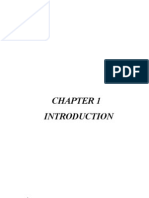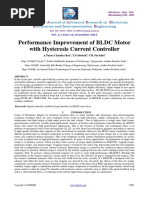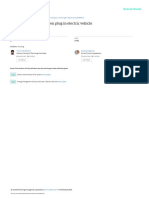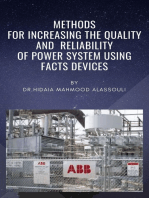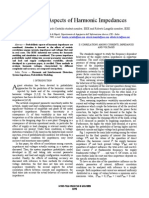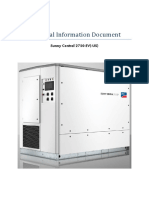Performance Analysis of Open Loop and Closed Loop
Uploaded by
Ady NusantaraPerformance Analysis of Open Loop and Closed Loop
Uploaded by
Ady NusantaraSee discussions, stats, and author profiles for this publication at: https://www.researchgate.
net/publication/325816620
Performance Analysis of Open Loop and Closed Loop Control in BLDC Drives for
Electrical Vehicle Applications
Article in International Journal of Computer Sciences and Engineering · April 2018
DOI: 10.26438/ijcse/v6i4.231235
CITATIONS READS
0 5,494
2 authors, including:
Senthil Kumar R
VIT University
64 PUBLICATIONS 387 CITATIONS
SEE PROFILE
All content following this page was uploaded by Senthil Kumar R on 12 April 2021.
The user has requested enhancement of the downloaded file.
International Journal of Computer Sciences and Engineering Open Access
Research Paper Volume-6, Issue-4 E-ISSN: 2347-2693
Performance Analysis of Open Loop and Closed Loop Control in BLDC
Drives for Electrical Vehicle Applications
M. Lincy Luciana1*, R. Senthil kumar2
1
Dept. of EEE, M.Kumarasamy College of Engineering, Tamil Nadu, India
2
Dept. of EEE, M.Kumarasamy College of Engineering, Tamil Nadu, India
*Corresponding Author: lincyluciana5792@gmail.com
Available online at: www.ijcseonline.org
Received: 23/Mar/2018, Revised: 31/Mar/2018, Accepted: 21/Apr/2018, Published: 30/Apr/2018
Abstract— This paper deals with analysis implementation of open loop and closed loop speed control for a Brushless dc
(BLDC) motor drive using Hysteresis and MRAC. Mostly BLDC drives are used for electrical vehicle applications. Generally
control algorithms which are developed for the motor drive might show good simulation results during steady state and
transient conditions. Model reference adaptive system is a control strategy to drive electrical machine. Conventional cascade PI
controllers are often used to control speed, torque and current. Adaptive PI controller for speed and current of a low inertia
machine, change in speed set point should be slowly applied in order avoid stability problem. Hysteresis current control is used
to eliminate voltage stability problem. In order to improve the performance compare to hysteresis current control the new
model reference adaptive system used in speed control block. So, here initially open loop and closed loop system of BLDC
drive using hysteresis current control is simulated and results are verified, after that MRAC is introduced to analysis
improvement and dynamic behaviour of system and performance are analysed using MATLAB/ SIMULINK software.
Hardware implementation of open loop BLDC drive system performance is validated by using DSP processor. In this project
detailed procedure of effectively controlled the BLDC drive real time is presented.
Keywords— BLDC motors, PI controller, Model Reference Adaptive Control (MRAC)
I. INTRODUCTION input circuit. BLDC motor has the advantage of high starting
torque, high efficiency and high density compared to other
An electric motor or an electric generator’s performance
motors. BLDC motor is a open loop system where the
efficiency is generally determined by their speed of rotation.
current is not controlled. Hysteresis current controller is also
The machine’s speed can be easily controlled by applying
used for utility applications like low and medium voltage.
voltage and frequency of the source current. By
This project mainly involves in implementing control
implementing the concept of drive in electric motor or
strategy for speed control in BLDC motor drive. Comparing
generator the motor’s speed can be controlled more
with other techniques hysteresis current control has
accurately. The main advantage is motion control is
advantage of eliminating voltage stability problem[3] [4] [5].
optimized easily. These types of motors are generally used in
In this paper, we have discussed about the single
robots, fans, mills, pumps, industries etc. These drives are
phase half bridge rectifier harmonic content through some
also used as prime movers for diesel or petrol engines, gas
analytical expressions which employs either fixed or variable
turbines and hydraulic motors. These motors are used for
hysteresis current control and organised as follows Section I
vehicle and hybrid electric vehicles to improve energy
contains the introduction of BLDC motor and its control
efficiency [1] [2].
strategy, Section II contains Closed loop control of BLDC
Generally Brushless DC motor requires a DC source
motor by harmonic output of fixed band hysteresis current
which is in available form of AC. When an AC supply is
control is derived, Section III contains BLDC drive using
given to motor, the supplied AC supply gets converted into
MRAC and hysteresis controller by harmonic output
rectified DC and it is provided to BLDC drive. The diode
derivations of variable band hysteresis band, Section IV
bridge rectifier carries the process of rectification. To obtain
contains simulation models are developed by MATLAB
position of a rotor and speed, hall sensors are used. The
Simulink and the results are taken, section V concludes
usage of DC link capacitor is to provide DC supply to the
research work.
electronic commutation of brushless DC motor and also to
maintain constant DC voltage. This is to be fed to inverter
© 2018, IJCSE All Rights Reserved 231
International Journal of Computer Sciences and Engineering Vol.6(4), Apr 2018, E-ISSN: 2347-2693
II. CLOSED LOOP CONTROL OF BLDC DRIVE semiconductor devices like diode, SCR or TRIAC. These
semiconductor devices get turned on when gate signal is
Usually, BLDC motor drive requires control
triggered. Commutation is done either by natural or forced.
strategy to operate a motor at different speeds. Hence a
Here capacitor is incorporated so that the energy is stored
closed loop system is proposed. The proposed system
between input and output power. The three phase star
ensures BLDC motor drive runs at variable speed. Also here
connected BLDC motor can be described as the following
reference speed gets changed at any time which operates at
four eqautions:
desired speed. In a closed loop system, the motor speed is
given to the input side. Then it gets compared with reference (1)
speed to produce an error signal. The produced error signal is
fed to PI controller. Here the PI controller controls the speed (2)
of BLDC motor drive using the gain value of PI. The error
occurred in present and past are nullified by PI controller. (3)
This proportional and integral controller also provides value
for reference torque. The general structure of BLDC motor
with AC supply is shown in Fig 1[7]. (4)
In a three phase supply, phase voltages, phase
currents and phase back emf are denoted by v, I and e. the
electrical torque is represented as T e and load torque as TL.
Inductance L and Resistance R are used as per the phase
required. Here rotor inertia is denoted as J and friction
constant constant as Kf. The rotor speed is represented as wm.
By using the above parameters, the back emf and torque are
expressed by following mathematical expressions[8]
(5)
Fig 1. BLDC motor with AC supply
(6)
An input filter has used in a closed loop system to
avoid noise produced by input switching elements. This input (7)
filter crosses 50/60 Hz and attenuates high noise and
frequency. Reactive elements such as capacitors and PI controller with zero initial condition is given by
inductors play a major role in suppressing frequency.
Capacitors are connected in series and act as a high pass (8)
filters which DC is blocking. To avoid spikes at high voltage In integral error compensation, the actuating signal
in electric power, voltage dependent resistor is included in depends on the integral of the error. Proportional-integral
filter circuit. Fig 2 shows inverter control diagram of input controller is a special type of PID controller. Here the error
filter. derivative (D) is not used. Integral error compensation is to
eliminate steady state error but the system become sluggish
due to increase in order.
III. BLDC DRIVE USING MRAC AND HYSTERESIS
CONTROLLER
A.MRAC
The proposed system with MRAC (Model
Reference Adaptive Control) consists of controller with
closed loop where the parameters are desinged such that it
Fig 2. Closed loop control of BLDC motor can change the response of the system at any desired time.
The working of voltage source converter is to The system output gets compared with reference model of
convert AC supply into DC. To improve the efficiency of the desired response. The control parameters of a closed loop
VSC, power factor correction is needed. Here single stage controller gets updated based on the error produced.
PFC is used. Rectifiers are used by implementing
© 2018, IJCSE All Rights Reserved 232
International Journal of Computer Sciences and Engineering Vol.6(4), Apr 2018, E-ISSN: 2347-2693
Fig 4 shows as the control flow of hysteresis current
controller.
Fig.3 Control flow diagram of MRAC
The control flow diagram of MRAC is shown in fig Fig 4. Control flow of hysteresis current controller
3. Model reference adaptive control (MRAC) is a direct
adaptive control method that has controller parameters and The harmonic performance analysis of hysteresis
mechanisms which are adjustable. By comparing the PID inverter of both AC and DC system are analysed. These
controllers and adaptive controllers, these adaptive harmonics which is present in AC and DC voltages will
controllers are much efficient and also they are easy to affect the frequency of inverter.
handle changes in environment and unknown parameters. Using the demodulation technique of the inverter, the
This type of adaptive controller has two loops named as inner hysteresis current controller passes harmonic AC supply to
and outer loop. This paper mainly deals with adaptive the DC side of inverter. The switching fuction is not
controller. Control system is a process that regulates desingned inverter in hysteresis current controller so that
dynamics in system. Adaptive controller is a one of the harmonic currents are desinged by balancing DC input and
control strategy method that are popularly used. Generally, AC output power equations[10],[11].
BLDC motor with three phase supply operates in two phase
that produces high torque when the third phase is in off state.
The position of rotor are always dependent on the energized IV. SIMULATION RESULTS AND DISCUSSION
two phases. In MRAC position sensors are used where the It should MATLAB Simulink models are designed
signals are produced for every 60º of rotation. The rotor and and implemented for BLDC drive which operates without
stator field lines are 120º apart every interval time and gets current control and also for BLDC drives at fixed and
end when the rotor and stator field lines are 60º. When the variable speed in a closed loop.
stator and rotor field lines are in perpendicular, maximum
torque is achieved. The P-Controller is more complicated A.BLDC Motor without Current Control
than ON-OFF control process rather simple than PID The initial model designed is BLDC motor drive
controller which are used in automobile control[9]. without current control. The Simulink model design is a open
B.Hysteresis Current Controller loop system where the simulation results of BLDC drive
Hysteresis current controller is mainly used in low and stator current and back EMF is shown in figure 5. At the
medium voltage applications. Here the inverter line current output side of motor, trapezoidal back EMF can be taken.
tracks sinusoidal reference voltage with error margin. Line Figure 6 shows speed of BLDC motor drive without current
harmonics from inverter depends upon switching pattern. control in open loop system and figure 7 gives its toque
These switching patters are generated from line harmonics waveform.
feedback. Hysteresis current controller classified as follows:
a) Fixed band hysteresis control
b) Variable ban hysteresis control
Fixed band hysteresis control produces error current using
frequency modulated triangular wave. These results with
time varying characteristics that are computed from system.
© 2018, IJCSE All Rights Reserved 233
International Journal of Computer Sciences and Engineering Vol.6(4), Apr 2018, E-ISSN: 2347-2693
C. Open Loop BLDC Motor with Variable Speed
This Simulink is designed for brushless DC motor
with closed loop system that runs in variable speed is shown
in figure 11. This model is designed as BLDC motor drive
with current control. The BLDC motor drive stator current
and EMF is shown in figure 12. At the output side of motor,
trapezoidal back EMF can be taken. The corresponding
torque waveform was shown in figure 13.
Fig 5. Simulation of stator current with out current control
Fig 6. Simulation response of speed without current control
Fig 11. The Stator Current of BLDC motor drive
Fig 7. Simulation of torque response with out current control
B.Closed Loop BLDC Motor With Fixed Speed Fig 12. The speed of the open loop control for BLDC motor
This Simulink is designed for brushless DC motor
with closed loop system that runs in constant speed is shown
in figure 8. In figure 9, BLDC motor drive with current
control is shown. The BLDC motor drive stator current and
EMF is shown in figure 10.
Fig 13. Torque response at step time 0.6 sec
D. Closed Loop Control Of BLDC Motor Using MRAC
The model of BLDC motor drive with closed loop
Fig 8. BLDC motor with current control control using MRAC is designed and terminal voltage of
BLDC motor drive is shown in figure 14. The simulation
results of closed loop system rectifier current and back EMF
of BLDC motor is shown in figure 15.
Fig 9. BLDC motor drive with fixed speed
Fig 14. Terminal voltage of BLDC motor using MRAC
Fig 10. Torque response at step time 3.5 sec
© 2018, IJCSE All Rights Reserved 234
International Journal of Computer Sciences and Engineering Vol.6(4), Apr 2018, E-ISSN: 2347-2693
[12] Sundararju, K., and R. Senthil Kumar. "Modelling and analysis of
relative power system with cascaded multilevel inverter STATCOM
using fuzzy controller." Journal of advances in chemistry 12.10
(2016).
Authors Profile
M.Lincy Luciana received her B.E., degree in
Fig 15. Rectifier current of BLDC motor using MRAC Electrical and Electronics Engineering in 2013
from Sri Ramakrishna Institute of Technology,
Coimbatore, Tamilnadu. She received her M.E.,
degree in 2015 from the Dr.Mahalingam College
of Engineering, Pollachi, Tamilnadu. Now she is
working as an Assistant Professor in
M.Kumarasamy College of Engineering, Karur. She attended more
conferences and presented more papers in the field of her interest in
Power electronics and soft computing techniques.
R.Senthilkumar got UG degree from PSNA
Fig 16. Inverter voltage of BLDC motor using MRAC college of Engineering, Dindigul, Tamilnadu. He
got PG degree from the same college. He attended
V. CONCLUSION more conferences and presented more reputed
papers in the field of Power Electronics and
This works evaluate the different controlling strategies in Drives. Currently he is working as an Assistant
the BLDC motor to obtain better simulation results by using Professor in M.Kumarasamy College of
PI controllers. This helps in obtaining the controlled speed, Engineering, Karur. His interest is in the field of Power electronics
torque and current with better improvements. Here initially control and soft computing techniques.
open and closed loop system of BLDC drive using hysteresis
current controller helps in improving the simulation result and
with addition MRAC increase its performance. With the
overall concern DSP processor associated with hardware
components provides improved speed, torque and then the
current with the help of MATLAB.
REFERENCES
[1] Akin B, Bhardwaj M, Trapezoidal Control of BLDC Motor Using Hall
Sensors, Texas Instruments, 2010.
[2] Kenjo T, "Permanent magnet and brushless dc motors", Oxford,1985.
[3] Derek Liu, “Brushless DC Motors Made Easy,” Freescale, 2008.
[4] Domenico Arrigo, “L6235 Three Phase Motor Driver,” STAN1088,
2001.
[5] Feyzi M.R, Ebadpour M, Mozaffari Niapour S.A.KH, Arshya Feizi,
Mousavi.R Aghdam “A New Single Current Strategy for
HighPerformance Brushless DC Motor Drives”, International
Conference on Electrical and Computer Engineering, IEEE.
[6] Krishnan R, Permanent Magnet Synchronous and Brushless DC Motor
Drives, CRC Press, 2010.
[7] Miller T.J.E, "Brushless permanent magnet and reluctance
motordrive", Oxford, 1989
[8] Muhammad Mubeen, “Brushless DC Motor Primer,” Motion Tech
Trends, July, 2008.
[9] Padmaraja Yedamale,“Hands-on Workshop: Motor Control Part 4 -
Brushless DC (BLDC) Motor Fundamentals,” Microchip AN885,
2003.
[10] Samitha Ransara H.K, Madawala U.K “A Low Cost Drive for Three
Phase Operation of Brushless DC Motors”, International conference on
IEEE Industrial Electronics Society, IECON 2011, pp. 1692 - 1697.
[11] “Sensorless BLDC Motor Control and BEMF Sampling Methods with
ST7MC,” ST AN1946, July, 2007.
© 2018, IJCSE All Rights Reserved 235
View publication stats
You might also like
- Modelling and Simulation of Closed Loop BLDC Motor ControlNo ratings yetModelling and Simulation of Closed Loop BLDC Motor Control30 pages
- Speed Control of BLDC Motor Drive For Various ApplicationsNo ratings yetSpeed Control of BLDC Motor Drive For Various Applications6 pages
- Closed-Loop Control of BLDC Motor in Electric Vehicle ApplicationsNo ratings yetClosed-Loop Control of BLDC Motor in Electric Vehicle Applications5 pages
- Performance Analysis of BLDC Motors and Its Various Control StrategiesNo ratings yetPerformance Analysis of BLDC Motors and Its Various Control Strategies11 pages
- Speed Control of BLDC Motor Using PI & Fuzzy Approach: A Comparative StudyNo ratings yetSpeed Control of BLDC Motor Using PI & Fuzzy Approach: A Comparative Study4 pages
- Performance Improvement of BLDC Motor With Hysteresis Current ControllerNo ratings yetPerformance Improvement of BLDC Motor With Hysteresis Current Controller8 pages
- 2022.05.J. A_Review_of_BLDC_Motor_State_of_Art_Advanced_Control_Techniques_and_ApplicationsNo ratings yet2022.05.J. A_Review_of_BLDC_Motor_State_of_Art_Advanced_Control_Techniques_and_Applications37 pages
- Brushless DC Motor Driven Plug in Electric VehicleNo ratings yetBrushless DC Motor Driven Plug in Electric Vehicle6 pages
- Modelling of Sensored Speed Control of BNo ratings yetModelling of Sensored Speed Control of B11 pages
- Speed Control of Brushless DC Motor Using Conventional ControllersNo ratings yetSpeed Control of Brushless DC Motor Using Conventional Controllers9 pages
- 2014-Arwindra-Synthesis Modeling of 10 KW BLDC Controller Using PSIMNo ratings yet2014-Arwindra-Synthesis Modeling of 10 KW BLDC Controller Using PSIM6 pages
- Control BLDC Motor Speed Using PID ControllerNo ratings yetControl BLDC Motor Speed Using PID Controller5 pages
- Ijert Ijert: Microcontroller Controlled BLDC Drive For Electric Vehicle Raju Yanamshetti, Juhi Nishat AnsariNo ratings yetIjert Ijert: Microcontroller Controlled BLDC Drive For Electric Vehicle Raju Yanamshetti, Juhi Nishat Ansari4 pages
- Microcontroller Controlled BLDC Drive Fo PDFNo ratings yetMicrocontroller Controlled BLDC Drive Fo PDF4 pages
- Speed Control of BLDC Motor Drive by Using Pid ControllersNo ratings yetSpeed Control of BLDC Motor Drive by Using Pid Controllers5 pages
- 2022.05.C. Comparative_analysis_of_Speed_control_of_BLDC_motor_using_PWM_and_Current_Control_TechniquesNo ratings yet2022.05.C. Comparative_analysis_of_Speed_control_of_BLDC_motor_using_PWM_and_Current_Control_Techniques5 pages
- Speed Control of BLDC Motor Using Hybrid Controller: Strart UpNo ratings yetSpeed Control of BLDC Motor Using Hybrid Controller: Strart Up49 pages
- Modeling of Sensorized BLDC Motor Speed Control UsingNo ratings yetModeling of Sensorized BLDC Motor Speed Control Using10 pages
- Investigation of Mathematical Modelling of Brushless DC motorBLDC Drives by Using MATLAB-SIMULINKNo ratings yetInvestigation of Mathematical Modelling of Brushless DC motorBLDC Drives by Using MATLAB-SIMULINK6 pages
- Speed Control of BLDC Motor Using PID Controller: I J A R E E I ENo ratings yetSpeed Control of BLDC Motor Using PID Controller: I J A R E E I E5 pages
- Speed Control of BLDC Motor For Electric PDFNo ratings yetSpeed Control of BLDC Motor For Electric PDF6 pages
- Closed-Loop Control of BLDC Motor Using Hall Effect SensorsNo ratings yetClosed-Loop Control of BLDC Motor Using Hall Effect Sensors8 pages
- Identification and Optimization Speed Control of BLDC Motor Using Fuzzy Logic ControllerNo ratings yetIdentification and Optimization Speed Control of BLDC Motor Using Fuzzy Logic Controller5 pages
- Review of Permanent-Magnet Brushless DC Motor Basic DrivesNo ratings yetReview of Permanent-Magnet Brushless DC Motor Basic Drives28 pages
- Design and Implementation of A 350-Watt BLDC MotorNo ratings yetDesign and Implementation of A 350-Watt BLDC Motor8 pages
- Mathematical modeling of bldc motor with closed loop speed control using pidNo ratings yetMathematical modeling of bldc motor with closed loop speed control using pid9 pages
- Performance Enhancement of BLDC Motor Using PID ControllerNo ratings yetPerformance Enhancement of BLDC Motor Using PID Controller10 pages
- Methods for Increasing the Quality and Reliability of Power System Using FACTS DevicesFrom EverandMethods for Increasing the Quality and Reliability of Power System Using FACTS DevicesNo ratings yet
- Harmonics With Delta AC Inverter ProductsNo ratings yetHarmonics With Delta AC Inverter Products43 pages
- Probabilistic Aspects of Harmonic ImpedancesNo ratings yetProbabilistic Aspects of Harmonic Impedances6 pages
- Energies: Design and Comparison of The Performance of 12-Pulse Rectifiers For Aerospace ApplicationsNo ratings yetEnergies: Design and Comparison of The Performance of 12-Pulse Rectifiers For Aerospace Applications23 pages
- Power Quality Management in Smart Grids: Issues and ImprovementsNo ratings yetPower Quality Management in Smart Grids: Issues and Improvements5 pages
- Design Guide 2015 LV Power Factor Correction Cubicles Panel Builder Guide100% (2)Design Guide 2015 LV Power Factor Correction Cubicles Panel Builder Guide72 pages
- Line Harmonics Filter (LHF) - Input Options - SINAMICS G130No ratings yetLine Harmonics Filter (LHF) - Input Options - SINAMICS G1303 pages
- Power Quality and Grid Code Issues in Wind Energy Conversion SystemNo ratings yetPower Quality and Grid Code Issues in Wind Energy Conversion System17 pages
- Training of Trainer Programme:: National Certification Scheme For Energy Auditors and Managers in PakistanNo ratings yetTraining of Trainer Programme:: National Certification Scheme For Energy Auditors and Managers in Pakistan45 pages
- Capacitor Switching Transient: A Review: Amar Jambukar, M. F. A. R. SatarkarNo ratings yetCapacitor Switching Transient: A Review: Amar Jambukar, M. F. A. R. Satarkar8 pages
- Electric Power Quality: by S. S. (Mani) Venkata Iowa State University Ames, IowaNo ratings yetElectric Power Quality: by S. S. (Mani) Venkata Iowa State University Ames, Iowa57 pages
- Power Quality White Paper From SchneiderNo ratings yetPower Quality White Paper From Schneider10 pages
- Feasibility Study: St. Joseph County Public LibraryNo ratings yetFeasibility Study: St. Joseph County Public Library56 pages
- Grid Code Compliance For Integrating 50 MW Wind Farm Into Dhofar Power GridNo ratings yetGrid Code Compliance For Integrating 50 MW Wind Farm Into Dhofar Power Grid11 pages
- Impact of Electric Vehicle Charging Station On Power QualityNo ratings yetImpact of Electric Vehicle Charging Station On Power Quality8 pages
- Modelling and Simulation of Closed Loop BLDC Motor ControlModelling and Simulation of Closed Loop BLDC Motor Control
- Speed Control of BLDC Motor Drive For Various ApplicationsSpeed Control of BLDC Motor Drive For Various Applications
- Closed-Loop Control of BLDC Motor in Electric Vehicle ApplicationsClosed-Loop Control of BLDC Motor in Electric Vehicle Applications
- Performance Analysis of BLDC Motors and Its Various Control StrategiesPerformance Analysis of BLDC Motors and Its Various Control Strategies
- Speed Control of BLDC Motor Using PI & Fuzzy Approach: A Comparative StudySpeed Control of BLDC Motor Using PI & Fuzzy Approach: A Comparative Study
- Performance Improvement of BLDC Motor With Hysteresis Current ControllerPerformance Improvement of BLDC Motor With Hysteresis Current Controller
- 2022.05.J. A_Review_of_BLDC_Motor_State_of_Art_Advanced_Control_Techniques_and_Applications2022.05.J. A_Review_of_BLDC_Motor_State_of_Art_Advanced_Control_Techniques_and_Applications
- Brushless DC Motor Driven Plug in Electric VehicleBrushless DC Motor Driven Plug in Electric Vehicle
- Speed Control of Brushless DC Motor Using Conventional ControllersSpeed Control of Brushless DC Motor Using Conventional Controllers
- 2014-Arwindra-Synthesis Modeling of 10 KW BLDC Controller Using PSIM2014-Arwindra-Synthesis Modeling of 10 KW BLDC Controller Using PSIM
- Ijert Ijert: Microcontroller Controlled BLDC Drive For Electric Vehicle Raju Yanamshetti, Juhi Nishat AnsariIjert Ijert: Microcontroller Controlled BLDC Drive For Electric Vehicle Raju Yanamshetti, Juhi Nishat Ansari
- Speed Control of BLDC Motor Drive by Using Pid ControllersSpeed Control of BLDC Motor Drive by Using Pid Controllers
- 2022.05.C. Comparative_analysis_of_Speed_control_of_BLDC_motor_using_PWM_and_Current_Control_Techniques2022.05.C. Comparative_analysis_of_Speed_control_of_BLDC_motor_using_PWM_and_Current_Control_Techniques
- Speed Control of BLDC Motor Using Hybrid Controller: Strart UpSpeed Control of BLDC Motor Using Hybrid Controller: Strart Up
- Modeling of Sensorized BLDC Motor Speed Control UsingModeling of Sensorized BLDC Motor Speed Control Using
- Investigation of Mathematical Modelling of Brushless DC motorBLDC Drives by Using MATLAB-SIMULINKInvestigation of Mathematical Modelling of Brushless DC motorBLDC Drives by Using MATLAB-SIMULINK
- Speed Control of BLDC Motor Using PID Controller: I J A R E E I ESpeed Control of BLDC Motor Using PID Controller: I J A R E E I E
- Closed-Loop Control of BLDC Motor Using Hall Effect SensorsClosed-Loop Control of BLDC Motor Using Hall Effect Sensors
- Identification and Optimization Speed Control of BLDC Motor Using Fuzzy Logic ControllerIdentification and Optimization Speed Control of BLDC Motor Using Fuzzy Logic Controller
- Review of Permanent-Magnet Brushless DC Motor Basic DrivesReview of Permanent-Magnet Brushless DC Motor Basic Drives
- Design and Implementation of A 350-Watt BLDC MotorDesign and Implementation of A 350-Watt BLDC Motor
- Mathematical modeling of bldc motor with closed loop speed control using pidMathematical modeling of bldc motor with closed loop speed control using pid
- Performance Enhancement of BLDC Motor Using PID ControllerPerformance Enhancement of BLDC Motor Using PID Controller
- Methods for Increasing the Quality and Reliability of Power System Using FACTS DevicesFrom EverandMethods for Increasing the Quality and Reliability of Power System Using FACTS Devices
- Energies: Design and Comparison of The Performance of 12-Pulse Rectifiers For Aerospace ApplicationsEnergies: Design and Comparison of The Performance of 12-Pulse Rectifiers For Aerospace Applications
- Power Quality Management in Smart Grids: Issues and ImprovementsPower Quality Management in Smart Grids: Issues and Improvements
- Design Guide 2015 LV Power Factor Correction Cubicles Panel Builder GuideDesign Guide 2015 LV Power Factor Correction Cubicles Panel Builder Guide
- Line Harmonics Filter (LHF) - Input Options - SINAMICS G130Line Harmonics Filter (LHF) - Input Options - SINAMICS G130
- Power Quality and Grid Code Issues in Wind Energy Conversion SystemPower Quality and Grid Code Issues in Wind Energy Conversion System
- Training of Trainer Programme:: National Certification Scheme For Energy Auditors and Managers in PakistanTraining of Trainer Programme:: National Certification Scheme For Energy Auditors and Managers in Pakistan
- Capacitor Switching Transient: A Review: Amar Jambukar, M. F. A. R. SatarkarCapacitor Switching Transient: A Review: Amar Jambukar, M. F. A. R. Satarkar
- Electric Power Quality: by S. S. (Mani) Venkata Iowa State University Ames, IowaElectric Power Quality: by S. S. (Mani) Venkata Iowa State University Ames, Iowa
- Feasibility Study: St. Joseph County Public LibraryFeasibility Study: St. Joseph County Public Library
- Grid Code Compliance For Integrating 50 MW Wind Farm Into Dhofar Power GridGrid Code Compliance For Integrating 50 MW Wind Farm Into Dhofar Power Grid
- Impact of Electric Vehicle Charging Station On Power QualityImpact of Electric Vehicle Charging Station On Power Quality


